RESOURCES - PUBLICATIONS
ACTIONS THAT TARNISH AN INDUSTRY, WHAT HAPPENS WHEN PESTICIDE APPLICATORS BECOME ENVIRONMENTAL POLLUTERS

Fred Whitford, Director, Purdue Pesticide Programs
Joe Becovitz, Pesticide Program Specialist, Office of Indiana State Chemist
John Obermeyer, Integrated Pest Management Specialist, Purdue University
Ann Kline, Director, Purdue Extension-Noble County
Aaron Kreider, Pesticide Investigator, Office of Indiana State Chemist
Kevin Leigh Smith, Continuing Lecturer and Communication Specialist, Purdue Agricultural
Sciences Education and Communication
Contents
Investigations Pinpoint Training Needs for Proper Disposal.. . . . . . . . . . . . . . . . . . .4
The ‘Pulling the Plug’ Award .. . . . . . . . . . . . . . . . . . . . . .4
The ‘Clever Intentions’ Award . . . . . . . . . . . . . . . . . . . .5
The ‘Collect and Release’ Award .. . . . . . . . . . . . . . .5
The ‘Disrespect for Everything’ Award .. . . . . . . . . . . . . . . . . . . . . . . . . . . . . . . . . . 6
Secrets Aren’t Always Kept .. . . . . . . . . . . . . . . . 7
Conclusion .. . . . . . . . . . . . . . . . . . . . . . . . . . . . . . . . . . . . . . . . . . . . . . . . . 7
Acknowledgements .. . . . . . . . . . . . . . . . . . . . . . . . . . . . . . . . 7
Disclaimer .. . . . . . . . . . . . . . . . . . . . . . . . . . . . . . . . . . . . . . . . . . . . . . . . . . 7
Regulatory agencies rarely need to respond to complaints related to poor pesticide disposal. Most businesses and farms dispose of leftover spray tank mixtures or tank rinse water by collecting, storing, and reusing them according to label instructions. Unfortunately, there are “bad apples,” who choose to illegally dispose of pesticides and their residues, which potentially can cause long-term harm to properties, production fields, and aquatic environments.
With today’s heightened awareness of fragile ecosystems, it is a gut-punch when someone gets caught polluting our environment. Your initial response might be something like, “You’ve got to be kidding! What makes someone think dumping leftover pesticide on the ground is a good idea?”
On further reflection, you may ask yourself:
- “Were they uninformed?”
- “Did their employer tell them to do this?”
- “Did they lack common sense?”
- “Were they simply bad actors with no regard for their actions?”
Both laws and common sense dictate that legal disposal and illegal disposal are polar opposites. Legally disposing of unused pesticides and rinsates is safe for the environment and retains a company’s reputation. Illegal disposal — whether done through ignorance, carelessness, or intentionally — can bring significant legal and financial repercussions to polluters, as well as long-term ramifications to the surrounding environment and wildlife.
A company (or “applicator-turned-polluter”) may be required to remediate a contaminated site, pay a civil fine, and defend themselves against criminal charges. This potential remediation, civil fine, and defense against criminal charges can result in huge expenses for the offender and even jail time. This publication highlights the need to continually train and remind pesticide professionals to properly handle pesticide products or handle residual pesticide products that remain in storage or original tanks after applications are complete.
INVESTIGATIONS PINPOINT TRAINING NEEDS FOR PROPER DISPOSAL
Pesticide labels inform users how to e ectively control pests. When used properly, the pesticide product should not harm the applicator, public, or environment. Labels also inform users how to dispose of leftover pesticides both in the original container and in application equipment.
Pouring or dumping pesticides on the ground is never a disposal option that pesticide product labels allow — nor do any local, state, or federal regulations. The following case files from the O ice of Indiana State Chemist (OISC) highlight examples of improper disposal practices.
THE ‘PULLING THE PLUG’ AWARD

Two OISC investigators were conducting a routine inspection at a golf course, focusing their initial attention on application records. With the records in good order, the superintendent and OISC investigators moved outside to examine the pesticide storage in a self-contained building.
One OISC investigator recalled, “I heard noise that sounded like running water gushing on the ground. I walked around the corner, and much to my surprise, I saw a greenish material running down the hill toward a ditch.”
The investigator ran to the employee asking, “What are you doing?” and “What’s in the tank?” The applicator had finished spraying the course with two fungicides, a wetting agent, 46-0-0 fertilizer, and a green dye used to track spray coverage. The employee then pulled the drain plug out of a 300-gallon sprayer to get rid of chemicals he no longer needed. Quick action by the superintendent to contain the spill kept the
material from reaching the drainage ditch.
The state pesticide investigator reported “I did not expect to see this. I didn’t think people still did this.”
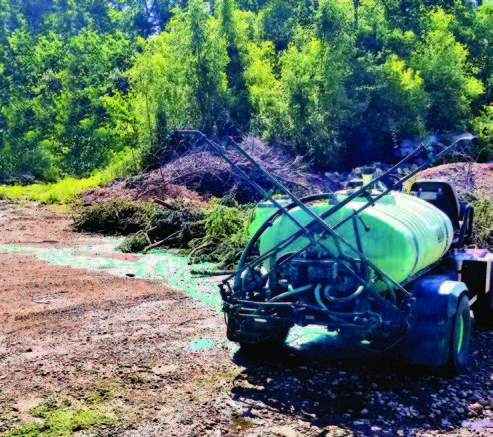
What Does the Product Label Say?
The label from one of the fungicides released at the golf course made a clear statement:
“PESTICIDE DISPOSAL: Pesticide wastes are toxic. Open dumping is prohibited. Improper disposal of excess pesticide, pesticide spray or rinsate is a violation of Federal law. If these wastes cannot be disposed of by use according to label instructions, contact your State Pesticide or Environmental Control Agency, or the Hazardous Waste representative at the nearest EPA Regional Office for guidance.”
It is clear the golf course and applicator were mismanaging products by illegal discharge. Catastrophe was narrowly avoided that day, but what if the pesticide had entered surface water, a homeowner’s well, or neighboring sensitive crops?
THE ‘CLEVER INTENTIONS’ AWARD
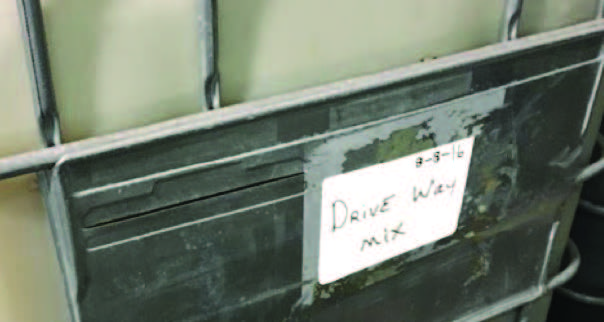
A disgruntled former employee alleged their former company applied herbicide-contaminated water (from rinsing minibulk tanks, spray tanks, and 2.5-gallon jugs) around a well and loading dock. The OISC investigator’s initial evaluation did not support the complaint after seeing healthy weeds growing around the well and in the loading dock area. Soil samples collected from around the well and loading dock area and a sample of well water did not detect herbicide contamination.
While completing a customary review of the entire facility, investigators noticed several unusually labeled minibulks. Some minibulks lacked regular pesticide product labels. Many had hand-written labels taped to them that read “Drive Way (sic) Mix.”
When asked about these oddly labeled containers, the new facility manager volunteered that the previous manager placed all their rinse water in 250-gallon minibulks. Instead of reusing rinse water as part of their application process or applying it to land owned by farmer clients, the company was giving the rinsate to anyone as a weed control for driveways. While the new manager eliminated that practice, there were still a number of these minibulks stored at the facility.
While the intent was good (that is, reusing the rinsate), the practice of giving rinse water to anyone with the possibility that it could be used anywhere, is considered improper disposal. One major issue was that some herbicide products contained in the “Drive Way Mix” were restricted-use pesticides, which can only be used legally by certified pesticide applicators.
There were several warning signs this “free” herbicide with no legal label was more trouble than it was worth:
• Can any homeowner really use 250 gallons
of herbicide in their lifetime?
• Where can it be safely stored?
• Where is the label with instructions for safe disposal? • What if unused product freezes over the winter,
cracks the container, and begins leaking?
This clever invention could have had many unintended consequences, including harming the applicator, others, and the environment.
THE ‘COLLECT AND RELEASE’ AWARD
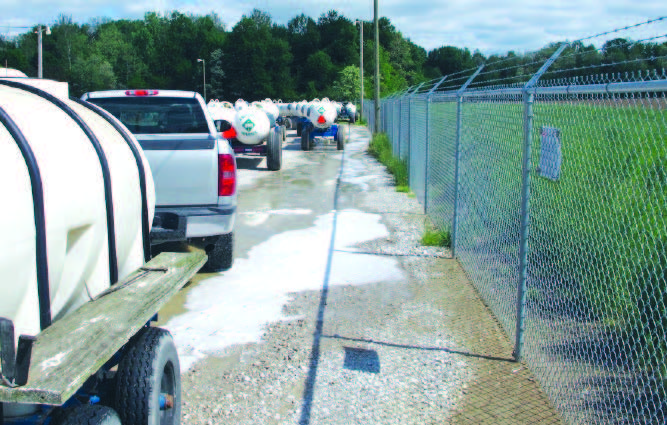
A landowner became concerned when he noticed significant erosion leading to the pond on his property. Worried about silting in the pond, the owner tracked the problem through his woods to an ag facility that bordered the property. The property owner noticed runo from the facility may have created the erosion. Now he also was concerned about potential contamination to the pond’s habitat and surrounding woods. He filed a complaint with OISC sharing his concerns about erosion and pesticide runoff.
An OISC investigator met with the complainant, took soil samples, and drove to the facility. When the investigator arrived, he saw a large nurse tank with discolored liquid gushing onto the ground. The investigator told two facility workers, “You need to stop this right now.” Upon inquiry, employees told the investigator the discharged material was water used to flush out minibulks before putting them back into service.
The OISC investigator followed the water to see where it flowed o the facility. The drainage pattern showed that the diluted chemical mixture funneled down to where it left the site; moved across a smaller soybean field; and then entered the complainant’s property, creating a trail to the pond. Soil samples collected at the facility detected high levels of herbicide residues, which indicated that the practice of dumping rinse water had been going on for some time. Fortunately, soil samples collected further away from the facility showed reduced herbicide residues.
The agricultural facility was required to change how they disposed of their rinse “water.” The facility operators were right to clean out the pesticide in their minibulks to prevent cross contamination. They also were right to collect the rinse water. But why go through the trouble of collecting and storing the rinse water only to dump it at another site?
THE ‘DISRESPECT FOR EVERYTHING’ AWARD

An informant contacted the U.S. Environmental Protection Agency (EPA) who then informed OISC of the complaint. The informant told the EPA and OISC investigators he had photographs that showed improper pesticide disposal. The former employee provided written statements of what he personally observed, which was backed by photographs he took on the day of the discharge.
He was on site with another employee, whose boss told him to go to the usual site and flush the tender truck. The employee knew what he was asked to do was not right, but he was put between a rock and a hard place: Do the right thing or lose my job?
The informant took plenty of photographs, not realizing how they might be used later. In collecting the names of the people involved, investigators contacted a recently retired person who said in a sworn statement, “I’ve been there 30 years, and we’ve been dumping that long at that same site.”
During the same period, a father and son lodged a separate complaint to the Indiana Department of Natural Resources (IDNR) and Indiana Department of Environmental Management (IDEM). The two were fishing and noticed dead fish lying along the bank. Initially, investigators concluded the fish died from high nitrate levels in the stream. Investigators identified the likely source of the nitrates as a nearby agricultural
facility.
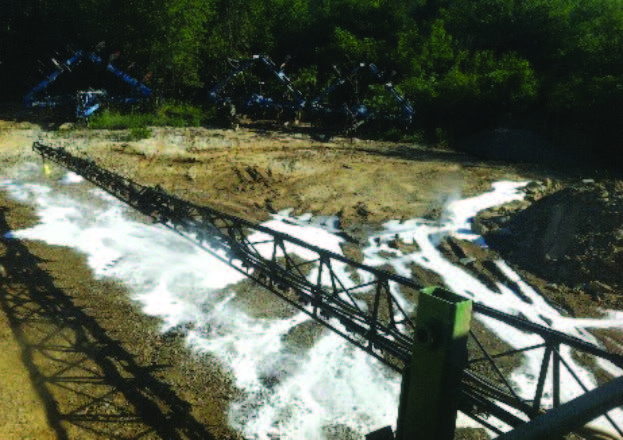
When the second complaint surfaced, investigators linked the possibility of the fish kill being connected to the illegal dumping of pesticides. Soil samples from both the dump site and creek showed high herbicide levels. Upstream of where the released material entered the creek, no pesticides were detected in the soil or water.
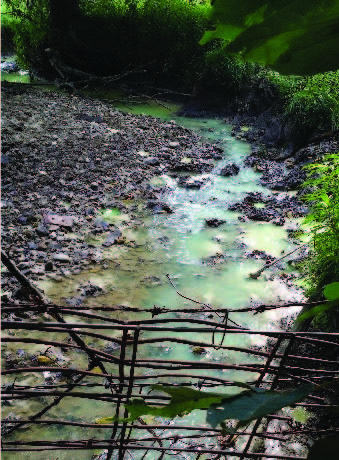
There was a history of more than 30 years of illegal pesticide disposal at this site. It was intentional, deliberate, and showed a complete disregard for the environment, pesticide labels, and the law. The OISC suspended the facility’s business license for six months, preventing them from selling pesticides or making applications. The pesticide certifications of the people involved were revoked, fines were assessed, and two managers were dismissed.
Secrets Aren’t Always Kept
Never assume illegal pesticide disposal activities are performed in secret. If you ask sta to dump pesticides, you better make sure they are employees for life. If you fire them, they make really good witnesses for the state against you. Former employees with direct knowledge of illegal activities can provide evidence of exactly what took place and where the “bodies are buried.”
The public is watching. The daily news should be enough to remind you that everyone with a smart phone can capture events as they unfold. These public videos can be used to initiate and/or corroborate investigatory findings. If you are an employee, what should you do if your employer or supervisor asks you to improperly dispose of pesticides?
First, try to convince company managers that dumping pesticides is unprofessional, doesn’t measure up to industry standards, harms the environment, endangers employees, and the company could face significant liabilities. It is possible that the people in charge may not fully understand or appreciate the risks associated with illegally dumping pesticides.
If they persist in ordering you to perform that task, then you must decide if you want to work for a company that blatantly disregards both their environmental responsibility and your liability as an employee. If you discharge the material, you too may face consequences for your actions, because ignorance of the law is not an excuse.
The more difficult dilemma is deciding what you should do with your evidence. Do you try to effect change from within the company? Do you report the information to authorities? Do you leave the company and look for employment elsewhere? Only you can answer these questions.
Conclusion
Properly disposing of pesticides protects both people and the environment. In the last few decades, commercial application industries and the farming community have made great strides in increasing the safety and awareness when handling pesticides, fertilizers, fuels, and animal manure. Unfortunately, because of the actions of a few, the public often perceives agriculture and commercial application industries as polluters, rather than protectors of crops, livestock, property, and stewards of the environment.
While the examples described in this publication are outliers, they remind us that we need to constantly educate owners and employees about environmental responsibility during applications, clean-out, and disposal of rinse water and leftover products.
True leaders in the industry work hard to protect crops and property against pests, while acting responsibly to protect their communities and the environment. They understand that these two goals go hand-in-hand — you can't have one without the other.
Acknowledgements
Thanks to Dawn Minns for graphic design. Thanks also to the following individuals who provided valuable comments and suggestions that improved this publication:
Elizabeth Carter - Office of Indiana State Chemist
John Garr - GarrCo Products
Matt Krausar - Indiana Department of Transportation
Brian Miller - Miller Risk Management
John Rebholz - Illinois Fertilizer and Chemical Association
Disclaimer
This publication is intended for educational purposes only. The authors’ views have not been approved by any government agency, business, or individual and cannot be construed as representing a perspective other than that of the authors. The publication is distributed with the understanding that the authors are not rendering legal or other professional advice to the reader, and that the information contained herein should not be regarded or relied upon as a substitute for professional consultation. The use of the information contained herein constitutes an agreement to hold the authors, companies, or reviewers harmless for liability, damage, or expense incurred as a result of reference to or reliance upon the information provided. Mention of a proprietary product or service does not constitute an endorsement by the authors or their employers.
Descriptions of specific situations are included only as hypothetical case studies to assist readers of this publication and are not intended to represent any actual person, business entity, or situation. Reference in this publication to any specific commercial product, process, or service, or the use of any trade, firm, or corporation name is for general informational purposes only and does not constitute an endorsement, recommendation, or certification of any kind by Purdue University. Individuals using such products assume responsibility that the product is used in a way intended by the manufacturer and misuse is neither endorsed nor condoned by the authors nor the manufacturer.
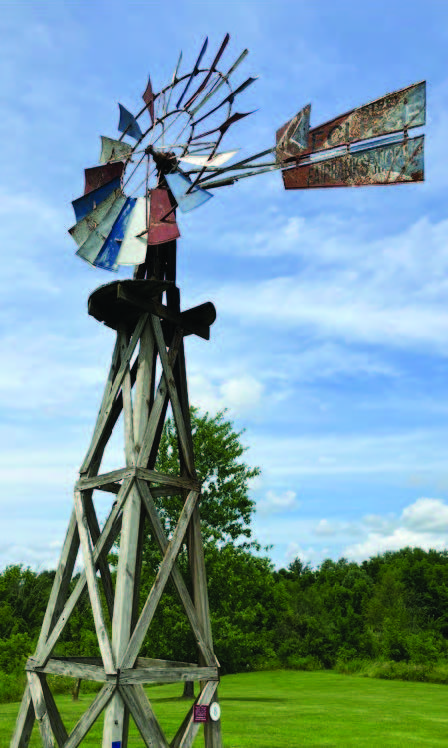
Reference in this publication to any specific commercial product, process, or service, or the use of any trade, firm, or corporation name is for general informational purposes only and does not constitute an endorsement, recommendation, or certification of any kind by Purdue Extension. Individuals using such products assume responsibility for their use in accordance with current directions of the manufacturer.
Find out more at
THE EDUCATION STORE
edustore.purdue.edu